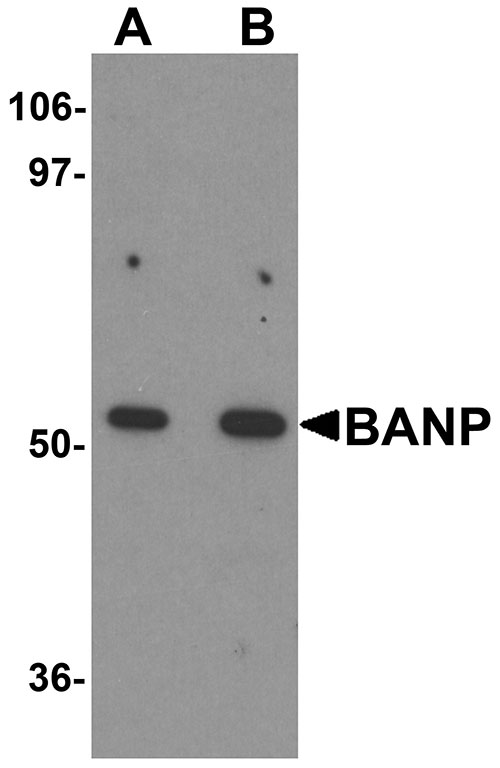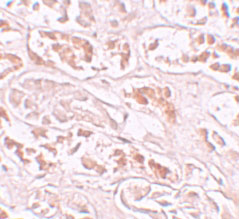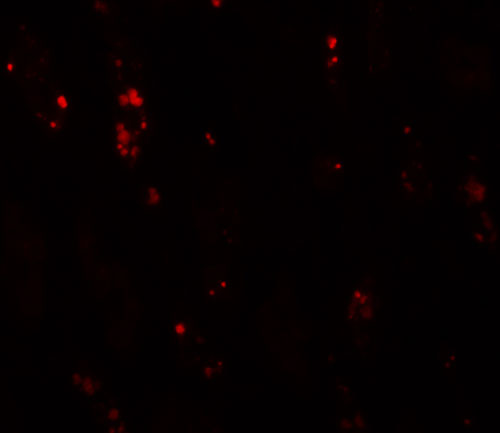BANP Antibody
- 产品详情
- 实验流程
- 背景知识
Application
| WB, IF, E, IHC-P |
|---|---|
| Primary Accession | Q8N9N5 |
| Other Accession | NP_001167014, 291084803 |
| Reactivity | Human, Mouse, Rat |
| Host | Rabbit |
| Clonality | Polyclonal |
| Isotype | IgG |
| Calculated MW | 56494 Da |
| Concentration (mg/ml) | 1 mg/mL |
| Conjugate | Unconjugated |
| Application Notes | BANP antibody can be used for detection of BANP by Western blot at 1 - 2 µg/mL. Antibody can also be used for immunohistochemistry starting at 10 µg/mL. For immunofluorescence start at 20 µg/mL. |
| Gene ID | 54971 |
|---|---|
| Other Names | Protein BANP, BEN domain-containing protein 1, Btg3-associated nuclear protein, Scaffold/matrix-associated region-1-binding protein, BANP, BEND1, SMAR1 |
| Target/Specificity | BANP; |
| Reconstitution & Storage | BANP antibody can be stored at 4℃ for three months and -20℃, stable for up to one year. As with all antibodies care should be taken to avoid repeated freeze thaw cycles. Antibodies should not be exposed to prolonged high temperatures. |
| Precautions | BANP Antibody is for research use only and not for use in diagnostic or therapeutic procedures. |
| Name | BANP |
|---|---|
| Synonyms | BEND1, SMAR1 |
| Function | Controls V(D)J recombination during T-cell development by repressing T-cell receptor (TCR) beta enhancer function (By similarity). Binds to scaffold/matrix attachment region beta (S/MARbeta), an ATC-rich DNA sequence located upstream of the TCR beta enhancer (By similarity). Represses cyclin D1 transcription by recruiting HDAC1 to its promoter, thereby diminishing H3K9ac, H3S10ph and H4K8ac levels (PubMed:16166625). Promotes TP53 activation, which causes cell cycle arrest (By similarity). Plays a role in the regulation of alternative splicing (PubMed:26080397). Binds to CD44 pre-mRNA and negatively regulates the inclusion of CD44 proximal variable exons v2-v6 but has no effect on distal variable exons v7-v10 (PubMed:26080397). |
| Cellular Location | Nucleus. Nucleus speckle. Cytoplasm Note=Primarily nuclear but translocates to the cytoplasm following MAPK1/MAPK3-mediated phosphorylation. |
| Tissue Location | Down-regulated in breast cancer cell lines. |
For Research Use Only. Not For Use In Diagnostic Procedures.
Provided below are standard protocols that you may find useful for product applications.
BACKGROUND
BANP Antibody: BANP was initially identified as a binding protein to BTG3 in a yeast two-hybrid screen. BANP acts as a tumor suppressor by stabilizing p53 expression and leading to cell cycle arrest. p53 in turn binds to upstream elements of the BANP promoter, thereby forming a feedback loop. BANP is down-regulated in advanced stages of human breast cancer, and its overexpression in breast cancer cell lines inhibits their ability to metastasize by modulating TGF-beta signaling. Furthermore, BANP can modulate NF-κB transactivation and can inhibit tumorigenesis by regulating NF-κB target genes. Recent experiments have shown that BANP can also repress HIV-1 LTR mediated transcription by tethering the LTR matrix attachment region to nuclear matrix.
REFERENCES
Birot A, Duret L, Bartholin L, et al. Identification and molecular analysis of BANP. Gene2000; 253:189-96.
Kaul R, Mukherjee S, Ahmed F, et al. Direct interaction with and activation of p53 by SMAR1 retards cell-cycle progression at G2/M phase and delays tumor growth in mice. Int. J. Cancer2003; 103:606-15.
Singh K, Mogare D, Giridharagopalan RO, et al. P%3 target gene SMAR1 is dysregulated in breast cancer: its role in cancer cell migration and invasion. PLoS One2007; 2:e660.
Signh K, Sinha S, Malonia SK, et al. Tumor suppressor SMAR1 repsses IkBa expression and inhibits p65 transactivation through matrix attachment regions. J. Biol. Chem.2009; 284:1267-78.
终于等到您。ABCEPTA(百远生物)抗体产品。
点击下方“我要评价 ”按钮提交您的反馈信息,您的反馈和评价是我们最宝贵的财富之一,
我们将在1-3个工作日内处理您的反馈信息。
如有疑问,联系:0512-88856768 tech-china@abcepta.com.























 癌症的基本特征包括细胞增殖、血管生成、迁移、凋亡逃避机制和细胞永生等。找到癌症发生过程中这些通路的关键标记物和对应的抗体用于检测至关重要。
癌症的基本特征包括细胞增殖、血管生成、迁移、凋亡逃避机制和细胞永生等。找到癌症发生过程中这些通路的关键标记物和对应的抗体用于检测至关重要。 为您推荐一个泛素化位点预测神器——泛素化分析工具,可以为您的蛋白的泛素化位点作出预测和评分。
为您推荐一个泛素化位点预测神器——泛素化分析工具,可以为您的蛋白的泛素化位点作出预测和评分。 细胞自噬受体图形绘图工具为你的蛋白的细胞受体结合位点作出预测和评分,识别结合到自噬通路中的蛋白是非常重要的,便于让我们理解自噬在正常生理、病理过程中的作用,如发育、细胞分化、神经退化性疾病、压力条件下、感染和癌症。
细胞自噬受体图形绘图工具为你的蛋白的细胞受体结合位点作出预测和评分,识别结合到自噬通路中的蛋白是非常重要的,便于让我们理解自噬在正常生理、病理过程中的作用,如发育、细胞分化、神经退化性疾病、压力条件下、感染和癌症。








